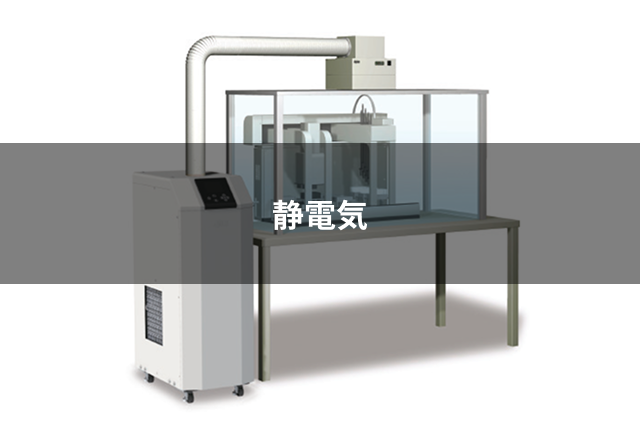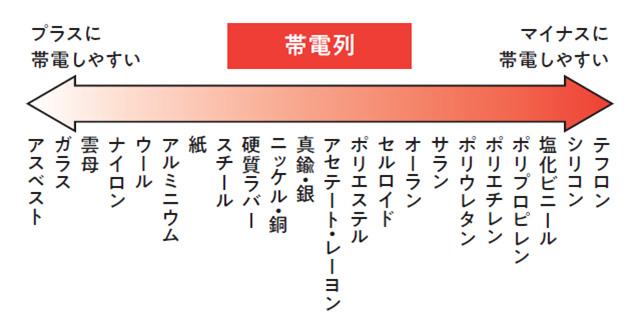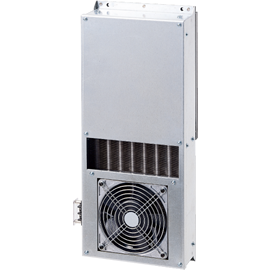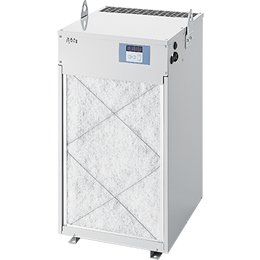static electricity

We will provide an easy-to-understand explanation of dehumidification, a topic that is often heard, starting with the basics of air, and explain the purpose and reasons for dehumidification, its uses in manufacturing processes, and typical dehumidification methods.
Table of Contents [display]
- What is static electricity?
- What is the static electricity potential?
- How static electricity is generated
- Triboelectric series and the likelihood of static electricity generation
- Types of static electricity
- The harmful effects of static electricity in production sites
- Typical anti-static measures
- Create environment static electricity is less likely to occur with Apiste PAU series
What is static electricity?
Static electricity refers to the state in which an object is electrically charged, or the charged electricity (charge) itself. Static electricity occurs on objects that do not easily conduct electricity, and is called static electricity because it remains static even when charged.
Many people have probably had the experience of touching a doorknob on a dry winter day and getting a bluish spark! (Ouch!) Or, as a child, you used to play by rubbing a paper pad under your armpit to make your hair stand up. It is well known that these phenomena are caused by static electricity.

What is the static electricity potential?
The shock to the human body caused by static electricity is called an electric shock, and the strength of the electric shock felt by the body and the electric potential (voltage) of the electric shock can be expressed as follows:
The bluish-white sparks of static electricity that you experience when you touch a doorknob in winter are about 10 kVA. Lightning also uses the same principle as static electricity discharge, but in the case of lightning, the discharge is said to be 10,000,000 to 1,000,000 kVA, and the current can reach tens of thousands of amperes.
| of the human body Electric shock potential (kVA) | The strength of the electric shock felt on the body | phenomenon | Static electricity buildup on clothing |
|---|---|---|---|
| 1.0 | I don't feel anything at all. | A faint sound of discharge | Walking on nylon carpet |
| 2.0 | I feel it on the outside of my fingers, but it doesn't hurt. | ||
| 3.0 | A sharp pain, like being pricked with a needle | ||
| 4.0 | A slight pain in the finger, as if a needle had pricked it deeply | Light emission during discharge is visible | Take off your polyester clothes Take off the acrylic sweater Folding an acrylic blanket |
| 5.0 | Pain from the palm to the forearm | Discharge light emanates from the fingertips | |
| 6.0 | Severe pain in the fingers and a heavy feeling in the back of the arm | ||
| 7.0 | Severe pain and numbness in the fingers and palms | ||
| 8.0 | Numbness from the palm of the hand to the forearm | ||
| 9.0 | Severe pain in the wrist and numbness in the hand | ||
| 10.0 | Pain and electrical sensation throughout the hand | A pale glow can be seen in the dark | |
| 11.0 | My fingers are very numb and I feel a strong electric shock all over my hand. | ||
| 12.0 | The whole hand feels like it's been hit |
"Electrostatic safety Guidelines" compiled by the Institute of Industrial safety
How static electricity is generated
First of all, objects have electrical properties because they are made up of atoms, and atoms are made up of nuclei and electrons.
The protons in the nucleus have a positive charge, and the electrons have a negative charge. Normally, the number of positive and negative charges is equal, creating an electrically balanced, neutral state. This is why no electricity flows when you touch them.
However, when contact or friction occurs and negatively charged electrons move from one object to the other, the charge balance is disrupted and each object becomes electrically unbalanced.
The one that has had its negative charge taken away becomes more positive, and the one that has had its negative charge taken away becomes more negative.
This state is called static electricity, and being charged with positive or negative static electricity is called being electrified. When a metal (conductor) comes into contact with an object in this charged state, the electricity is suddenly discharged (ESD).

Triboelectric series and the likelihood of static electricity generation
There are positive and negative static electricity, but some substances tend to be positively charged and others tend to be negatively charged. The order in which substances tend to be easily charged is called the triboelectric series.
When two objects are rubbed together, the object on the positive side tends to become positively charged, and the object on the negative side tends to become negatively charged.
The greater the distance between the two objects in the electrostatic column, the greater the static electricity that is generated.

Types of static electricity
Although all static electricity looks the same, it can be divided into three types depending on how it is generated: contact charging, friction charging, and peeling charging.
| kinds | Reason for occurrence | Cases of Occurrence |
|---|---|---|
| Contact charging | Occurs when objects come into contact with each other | When vacuuming, dust gets on the tip of the hose |
| friction wire | Generated by friction or contact between two objects | When I rub my head with a paperweight, my hair sticks to it. Taking off the sweater in winter |
| Peeling electrification | Occurs when two overlapping objects separate. | Peel off the wrapping film Remove protection film from your smartphone |
The harmful effects of static electricity in production sites
In industries with a lot of flammable materials, such as the chemical industry, there are apparently around 100 explosions and fires caused by static electricity discharges each year.
In particular, factories that handle explosive dust such as toner and carbon have experienced numerous large-scale dust explosions due to static electricity in the past. There have also been countless cases of electronic components and system equipment, such as semiconductors, being destroyed by static electricity discharge.
The harmful effects of static electricity in production sites include the following:
| The harmful effects of static electricity | Content |
|---|---|
| Adhesion of dirt | Static electricity causes dust and dirt to adhere to the product. |
| Electrostatic Discharge | Product destruction due to discharge of charged static electricity |
| Paint printing defects | Static electricity causes unevenness in painting and printing |
| Decrease in production efficiency | Film sticks to the equipment and clogs the feeder Powder adheres to or clogs the hopper or conveyor. |
| static electricity noise | Noise caused by static electricity discharge can cause equipment to malfunction. |
| Ignition and explosion | Electrostatic discharge can cause fires and explosions |
| Secondary electric shock disaster | Electric shock can cause you to drop things or slip. |
Typical anti-static measures
Connect the ground (earth)
In the case of conductors such as metal, static electricity can be channeled to the earth by connecting the ground.
However, if the material is an insulator such as rubber or glass, connecting it to earth will have no effect.
Wristbands, earth mats
Since workers are often electrically charged, static electricity can be released by wearing an earthed wristband or laying down an earthed mat while working.
Antistatic materials
In the case of insulating materials, static electricity can be suppressed by coating the surface with an antistatic material.
conductive materials
Applying a conductive material to the surface makes it easier for static electricity to escape, reducing the buildup of static electricity.
In addition, by kneading conductive materials into resins, etc., static electricity can be more easily released, making them less likely to become charged.
Static eliminator/ionizer
Static electricity can be removed by injecting an opposite charge into a charged object, electrically neutralizing it.
Humidity control (humidification)
As shown in the table below, static electricity becomes less likely to build up as humidity increases.
Generally, when the relative humidity exceeds 60%, the electrostatic voltage drops sharply, so humidity control through appropriate humidification is also a very effective countermeasure against static electricity.
| Static electricity source (charged object) | Relative humidity 10-20% | 65-90% relative humidity | |
|---|---|---|---|
| Human body walking on carpet | 35,000V | → | 1,500V |
| Human body walking on vinyl floor | 12,000V | → | 250V |
| Table workers | 6,000V | → | 100V |
| vinyl packaging materials | 7,000V | → | 600V |
| Pick up a regular plastic bag from the workbench | 20,000V | → | 1,200V |
| Urethane cushioned chair | 18,000V | → | 1,500V |
(From MIL-HDBK-773A)
Also, as shown in the figure on the bottom right, as humidity increases, electrical resistance decreases, which shortens the time it takes for static electricity to dissipate.

Create environment static electricity is less likely to occur with Apiste PAU series
Apiste 's PAU series precision air conditioner (TCU/ECU) are used as a countermeasure against static electricity in a wide range of manufacturing processes, including LCD and flat panel display manufacturing processes, electronic component manufacturing processes, and high-performance film and medical product manufacturing processes.
In particular, the PAU-GR-HC series is characterized by its ability to adjust temperature and humidity to optimal conditions.
















